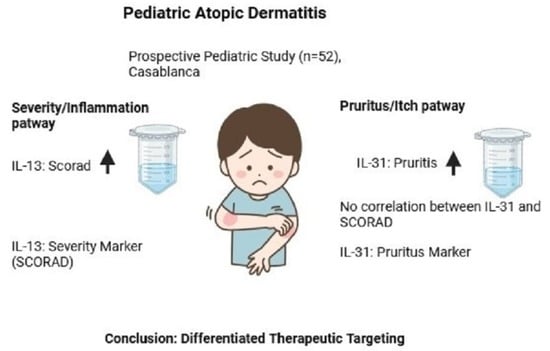- Article
Assessment of IL-13, IL-31 Levels and Disease Severity in Children with Atopic Dermatitis
- Sara Missaoui,
- Imane Abbari and
- Halima Kholaiq
- + 8 authors
Introduction: Atopic dermatitis (AD) is driven by complex pathways that mediate inflammation and pruritus. The pathophysiology of AD’s disease involves multiple pathways. Interleukin-13 (IL-13) is considered a major cytokine in Th2-type inflammation, responsible for changing the epidermal barrier and producing chronic inflammation, whereas interleukin-31 (IL-31) is considered a major inducer of pruritus. The exact correlation of each of these cytokines with disease severity in children with AD appears to vary across studies. This study was therefore designed to evaluate whether IL-13 and IL-31 levels contribute complementarily or independently to the overall clinical severity of AD in the Moroccan pediatric population and to analyze the correlation between serum IL-13 and IL-31 levels and investigate their correlation with disease severity in a pediatric cohort. Methods: A total of 52 children with moderate to severe AD were included. The severity of the disease was measured using the SCORing Atopic Dermatitis (SCORAD) index. Serum levels of IL-13 and IL-31 were measured by Enzyme-Linked Immunosorbent Assay (ELISA). Results: The IL-13 serum level showed a considerable positive correlation with the SCORAD score (rs = 0.7, p < 0.0001). On the other hand, IL-31 levels revealed no correlation with SCORAD (rs = 0.07, p = 0.62) but were positively correlated with pruritus intensity (rs = 0.91, p < 0.001). Conclusion: Our results support the presence of different pathophysiological axes in pediatric AD, where IL-13 functions as a reliable biomarker of inflammatory severity. IL-31 acts as a systemic marker of the pruritic pathway.
24 December 2025


